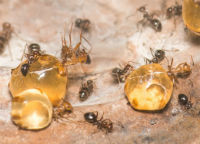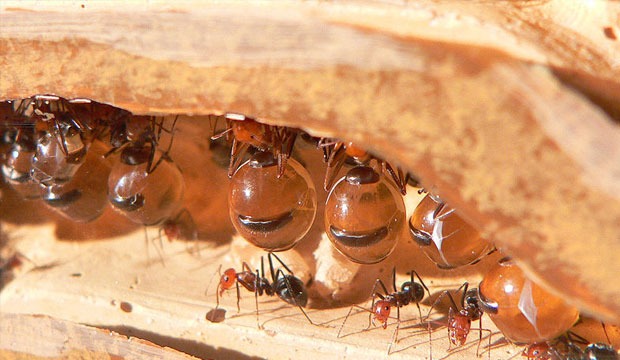The foundation of an empire
It is a dark and stormy night in the desert of Arizona. It is the perfect night for a tale of a rise to power. Our story begins when a small, honey ant queen lands after a mating flight in a spot she thinks is a good place to start a colony. This decision is crucial and may be the deciding factor in whether the colony survives. The queen starts to dig a small nest in the ground. After some time, another queen ant of the same species comes and starts to aid the original queen in the nest digging. Before the second queen can start to help though, she is rigorously inspected by the first. Before long, three other queens join the digging and are similarly inspected by the two original queens. This type of cooperation between queens is extremely rare, but if the queens can cooperate, their colony will become very powerful, very quickly. When the nest is deemed fit, the queens move into their permanent home.
The queens all begin to lay their first batch of eggs. The tiny, oval-shaped eggs are meticulously cleaned by the queens so that the eggs don’t develop fungi. There are

over three hundred eggs in all; while most colonies would only have about fifty eggs, the queen’s cooperation has put them into a good spot. When the eggs reach adulthood, the colony will become an instant superpower. The eggs hatch into small, translucent larvae. The larvae have voracious appetites and the queens feed them by breaking down their own muscle tissue and regurgitating it for the larvae to eat. The queens all begin to lay their first batch of eggs. The tiny, oval-shaped eggs are meticulously cleaned by the queens so that the eggs don’t develop fungi. There are over three hundred eggs in all; while most colonies would only have about fifty eggs, the queen’s cooperation has put them into a good spot. When the eggs reach adulthood, the colony will become an instant superpower. The eggs hatch into small, translucent larvae. The larvae have voracious appetites and the queens feed them by breaking down their own muscle tissue and regurgitating it for the larvae to eat.
Only the strongest and most dominant queen shall remain
The first workers emerge a few days later. They are tiny and translucent, but as their bodies harden, the shells become darker. The workers venture out into their new mysterious world. They immediately start to lay down pheromone trails so that other ants can follow them. The ants begin to forage for food; ants will eat almost anything edible, from dead insects to fresh plants. A little distance away from the nest, the ants find a rival ant nest. Some of the ants scout out the nest and learn that there is only one queen inside of it. One ant brings the news back to the queens, and a raiding party is sent out. The ants easily overwhelm the rival nest and kill all of the ants and the queen inside. They spare the larvae and eggs and bring them back to the nest to let them grow into workers for the colony. These ants are essentially slaves and perform duties such as cleaning the larvae and building the nest.
Some of the workers begin to pay extra attention to two of the queens. This attention is a signal that the queen choosing process is about to begin. This process is when ants kill all of the weaker queens. This extra attention gradually is replaced by the starvation of the queen, and finally, the ants kill and eat her. This process is repeated until the strongest queen remains.
The cycle continues
A few days later, a threat emerges. A giant green iguana sits down in front of the nest and snaps up all of the ants coming out of it. To retaliate dozens of ants swarm the iguana biting all of the vulnerable parts such as the eyes, mouth, and inside of the nose. This drives the iguana out for a while. The colony prospers through winter and spring. In the summer, the colony is finally ready to reproduce. The queen lays a few eggs that are given special care and extra food; these ants are going to be the new queens. After the eggs hatch, the mating process begins and the cycle repeats again.

